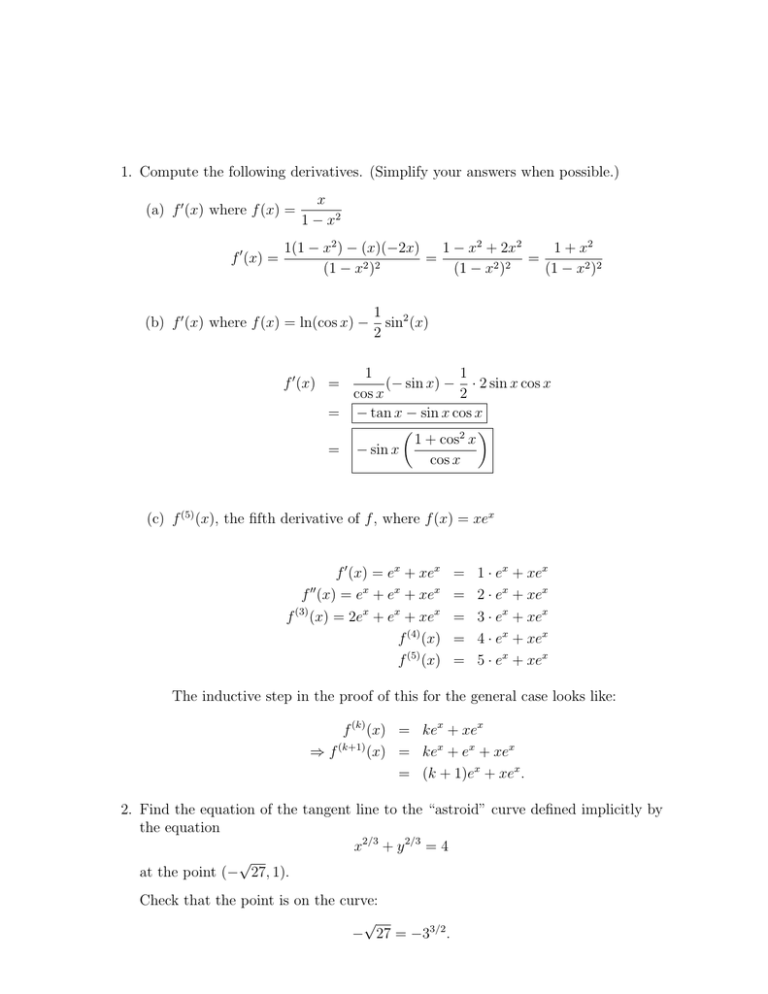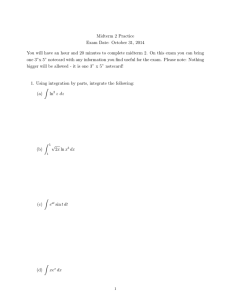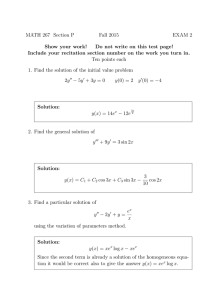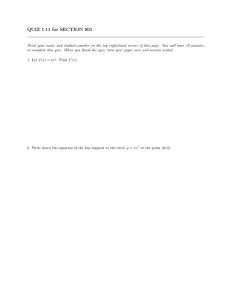1. Compute the following derivatives. (Simplify your answers... x (a) f (x) where f (x) =
advertisement

1. Compute the following derivatives. (Simplify your answers when possible.) (a) f � (x) where f (x) = f � (x) = x 1 − x2 1(1 − x2 ) − (x)(−2x) 1 − x2 + 2x2 1 + x2 = = (1 − x2 )2 (1 − x2 )2 (1 − x2 )2 (b) f � (x) where f (x) = ln(cos x) − 1 2 sin (x) 2 1 1 (− sin x) − · 2 sin x cos x cos x 2 = − tan x − sin x cos x � � 1 + cos2 x = − sin x cos x f � (x) = (c) f (5) (x), the fifth derivative of f , where f (x) = xex f � (x) = ex + xex f �� (x) = ex + ex + xex f (3) (x) = 2ex + ex + xex f (4) (x) f (5) (x) = = = = = 1 · ex + xex 2 · ex + xex 3 · ex + xex 4· ex + xex 5· ex + xex The inductive step in the proof of this for the general case looks like: f (k) (x) = kex + xex ⇒ f (k+1) (x) = kex + ex + xex = (k + 1)ex + xex . 2. Find the equation of the tangent line to the “astroid” curve defined implicitly by the equation x2/3 + y 2/3 = 4 √ at the point (− 27, 1). Check that the point is on the curve: √ − 27 = −33/2 . (−33/2 )2/3 + (1)2/3 = 3 + 1 = 4. � dy �� Use implicit differentiation to get dx � (−√27,1) x2/3 + y 2/3 2 −1/3 2 −1/3 dy x + y 3 3 dx dy x−1/3 + y −1/3 dx dy dx = 4 = 0 = 0 x−1/3 = − −1/3 y (−33/2 )−1/3 = − 1 dy 1 = 3−1/2 = √ . dx 3 1 The slope of the tangent line is √ . The point-slope formula tells us that the 3 equation of the tangent line is: √ 1 y − 1 = √ (x + 27) 3 √ 1 y = √ x+ 9+1 3 1 y = √ x + 4. 3 3. A particle is moving along a vertical axis so that its position y (in meters) at time t (in seconds) is given by the equation y(t) = t3 − 3t + 3, t ≥ 0. Determine the total distance traveled by the particle in the first three seconds. Cubic functions tend to increase, then decrease, then increase; we may need to break the journey into three parts to get the total (not net) distance traveled. Thus, we start by finding the max. and min. of y(t). To find the min/max we set y � (t) = 0 and solve for t: y � (t) = 3t2 − 3 = 3(t2 − 1) = 0 ⇒ t = ±1. Note that y � (t) > 0 for t < −1 and t > 1 and y � (t) < 0 for −1 < t < 1, so the particle is initially descending and then at t = 1 it starts to ascend. y(0) = 3 y(1) = 1 − 3 + 3 = 1 y(3) = 27 − 9 + 3 = 21 The total distance traveled is (3 − 1) + (21 − 1) = 22. � �� � � �� � up down 4. State the product rule for the derivative of a pair of differentiable functions f and g using your favorite notation. Then use the DEFINITION of the derivative to prove the product rule. Briefly justify your reasoning at each step. If f and g are both differentiable functions of x, then: (f · g)� (x) = f � (x)g(x) + f (x)g � (x). f (x + h)g(x + h) − f (x)g(x) h→0 h f (x + h)g(x + h) − f (x)g(x + h) + f (x)g(x + h) − f (x)g(x) = lim h→0 h � � f (x + h)g(x + h) − f (x)g(x + h) f (x)g(x + h) − f (x)g(x) = lim + h→0 h h � � f (x + h) − f (x) g(x + h) − g(x) = lim g(x + h) + f (x) h→0 h h (f · g)� (x) = lim Because f and g are differentiable they must be continuous, so limh→0 g(x + h) = g(x). Therefore: � � f (x + h) − f (x) g(x + h) − g(x) � (f · g) (x) = lim h → 0 g(x + h) + f (x) h h � � = f (x)g(x) + f (x)g (x). 5. Does there exist a set of real numbers a, b and ⎧ −1 ⎪ ⎨tan (x) f (x) = ax2 + bx + c, ⎪ ⎩ 3 1 2 x − 4 x + 5, c for which the function x≤0 0<x<2 x≥2 is differentiable (i.e. everywhere differentiable)? Explain why or why not. (Here tan−1 (x) denotes the inverse of the tangent function.) We start by finding the constraints on a, b and c under which the function is continuous: tan−1 (0) = 0 ⇒ c = 0. At x = 2: 1 23 − 22 + 5 = 8 − 1 + 5 = 12. 4 2 Therefore a · 2 + b · 2 + c = 12, ⇒ 4a + 2b = 12, ⇒ b = 6 − 2a. Next we find the conditions that ensure differentiability at x = 0 and x = 2. � � 1 1 � 2 f (x)|x=2 = 3x − x = 3 · 4 − · 2 = 11. 2 x=2 2 So we want: [2ax + b]x=2 = 4a + b = 11. In order for the function to be continuous we must have b = 6 − 2a, so if f is both differentiable and continuous 4a + (6 − 2a) = 11 ⇒ a = 5/2, b = 1. If f is differentiable then a = 5/2, b = 1 and c = 0. We must check that under these conditions, f is differentiable at x = 0. At x = 0 the derivative of 52 x2 + x is 5 · 0 + 1 = 1. 1 then we must apply 1 + x2 implicit differentiation to the function tan y = x to re-derive this fact, as presented 1 in lecture. At x = 0 the derivative of tan−1 (x) is 1+0 = 1. If we have forgotten that the derivative of tan−1 (x) is We conclude that when a = 5/2, b = 1 and c = 0, the function f (x) defined above is differentiable. 6. Suppose that f satisfies the equation f (x + y) = f (x) + f (y) + x2 y + xy 2 for all real numbers x and y. Suppose further that f (x) = 1. x→0 x lim (a) Find f (0). f (x) Since lim = 1, f (x) → 0 as x → 0, so f (0) = 0. x→0 x (b) Find f � (0). f (0 + h) − f (0) f (h) = lim = 1. h→0 h→0 h h f � (0) = lim (c) Find f � (x). f (x + h) − f (x) h→0 h f (x) + f (h) + x2 h + xh2 − f (x) lim h→0 h� � f (h) + x2 + xh lim h→0 h 1 + x2 + 0 x2 + 1 f � (x) = lim = = = = MIT OpenCourseWare http://ocw.mit.edu 18.01SC Single Variable Calculus�� Fall 2010 �� For information about citing these materials or our Terms of Use, visit: http://ocw.mit.edu/terms.



![Student number Name [SURNAME(S), Givenname(s)] MATH 100, Section 110 (CSP)](http://s2.studylib.net/store/data/011223976_1-c88f73f0d0b100fe6677b7d4e0bb72cf-300x300.png)

